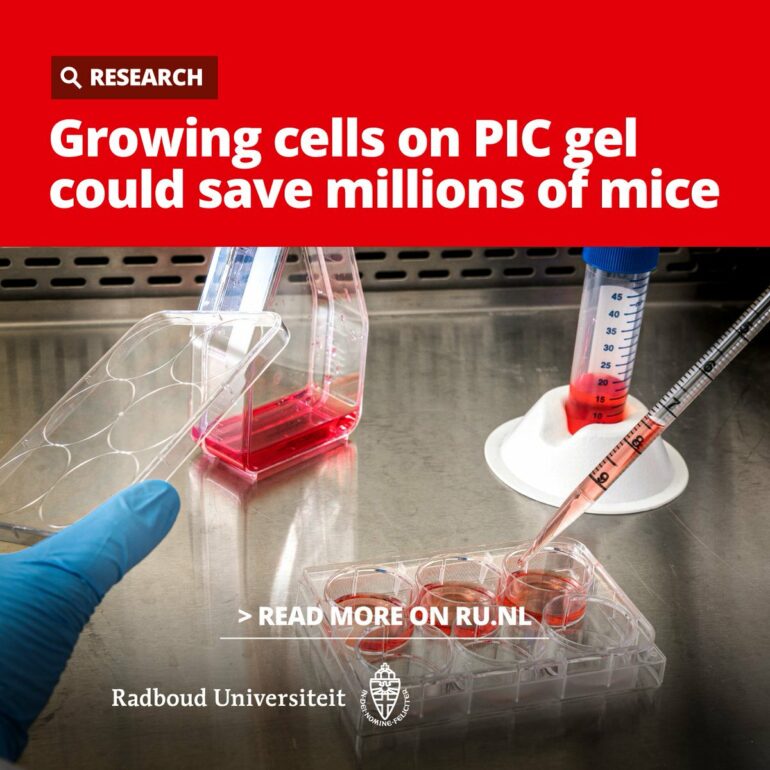The synthetic PIC gel, discovered in 2013 by Radboud University chemists, appears to behave like collagen. This makes the gel very useful for studying interactions between cells and their immediate environment. In practice, this means that the gel seems highly suitable to grow cells in for biological and clinical research. An additional advantage is that unlike the gels commonly used for cell culture, this gel requires no breeding and killing of mice. The latest findings were published on April 4 in Proceedings of the National Academy of Sciences.
When cells are grown on tissue culture plastic (in vitro), they do not behave exactly as they do in the body. The composition of the material wherein the cells are grown is very important. Ideally, you want the material you use to resemble as many aspects of the body as possible, and these properties should always remain the same, so that the results of different cell cultures are easy to compare.
So far, researchers (such as doctors and drug development researchers) have often used Matrigel for their cell cultures. This biological gel is made from mouse tumors. Paul Kouwer, molecular chemist at Radboud University, states, “A huge drawback of Matrigel is that it requires breeding and killing millions of mice every year. Moreover, no two mice are exactly alike, so the material is also variable.”
A synthetic gel is a fantastic alternative. Earlier research already showed that the PIC gel, discovered and developed at Radboud University, is suitable for growing human cells. Now, Radboud University and KU Leuven researchers have shown that the PIC gel behaves exactly like collagen. Since many cells in our body are in a collagenous environment, this makes the gel even more suitable than previously thought—especially for research into precisely these kinds of cells.
Kouwer says, “Ideally, we’d like to replace all Matrigel with our PIC gel, which would allow us and all other users to know the exact composition. But we are aware of the fact that we will occasionally miss a biological (growth) factor. In those cases, we may need to add a part of Matrigel. In the lab, we’re working hard to identify and replace these factors as well.”
Another challenge may come from something known as the cost of change. “When researchers start using new materials, the new results are no longer directly comparable to older data. This will definitely take some convincing.”
Animal-free application
This discovery is “quite fundamentally biophysical,” Kouwer explains, “but it represents a real breakthrough.” When it comes to its application, there is still some way to go. With the support of Radboud University knowledge transfer officers, Ph.D. student Lotte Gerrits is trying to find out what is needed to make PIC gel a successful application in this domain. In February, Gerrits and Kouwer won the Mercator Launch Innovation Competition, which can help them do just that. Currently, the researchers are also participating in the Proefdiervrij Venture Challenge, the final of which will take place on 21 April.
Kouwer explains, “How do I see the future? I would like this gel to contribute to personalized medicine where it can be used in the diagnosis and treatment of cancer. Using your own cells, from a biopt, to create a high-quality 3D cell culture will give us more information about what exactly is going on inside you. This is the idea that we submitted for the Proefdiervrij Venture Challenge, and it’s really inspiring.”
Kouwer was involved in the discovery of the PIC gel from the beginning, and in the process he has seen and heard more ideas for its application, such as to cover burns or internal wounds with the gel, which hardens at body temperature and dissolves with cooling. “There are still some ongoing projects in that area. But because you need large clinical trials for that, it is something for the longer term.”
The application of PIC gel for cell cultures can, Kouwer hopes, be realized more quickly. “We would prefer to do a proper pilot with a commercial party, to fully develop the material. I am convinced that we need to proceed with this. Imagine how great it would be if lots of researchers could use a controlled material for their lab research that does not require sacrificing mice.”
More information:
Hongbo Yuan et al, Synthetic fibrous hydrogels as a platform to decipher cell–matrix mechanical interactions, Proceedings of the National Academy of Sciences (2023). DOI: 10.1073/pnas.2216934120
Provided by
Radboud University
Citation:
Growing cells on synthetic PIC gel could save millions of mice (2023, April 5)



